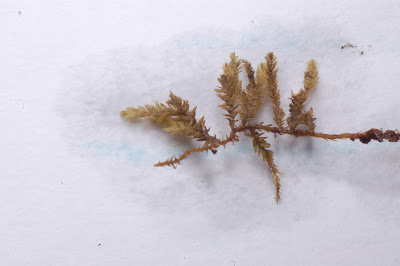Creeping Mosses Anomodon minor (Hedwig)
Anomodon minor (Hedwig) is a creeping moss occurring on bark at the bases of trees. It is distributed widely in North America, extending south to Hillsborough and Polk Counties in central Florida. |
| Anomodon minor has creeping primary stems with short, scale-like leaves and semi-erect branches with larger, tongue-shaped leaves. Photo from dried herbarium specimen: Merner s.n. 15 June 1979 (US) |
 |
Capsules of Anomodon minor are erect (unbent) and symmetrical.
Photo courtesy Robert A. Klips, Ohio Moss and Lichen Association.
|
Within the Anomodontaceae, Anomodon is distinguished from the only other genus, Herpetineuron, by the shape and other features of the leaves. In Herpetineuron, leaves gradually taper to a point and the cells are smooth, without papillae. Three other species of Anomodon occur in Florida. A. tristis appears to form thinner mats, occurs higher up on tree trunks, and is found only in the northern part of the state. A. attenuatus forms denser mats, with more frequently branched stems that lay more-or-less flat, and taper at the ends with increasingly smaller leaves. In A. rostratus, leaves are long and taper to a fine, hair-like point.
 |
| Leaves of Anomodon minor are elongate, tongue-shaped and with a rounded tip with small hard point. Cells are tiny, roundish and equipped with papillae. Lighter streak in the center is the midrib. |
No comments:
Post a Comment